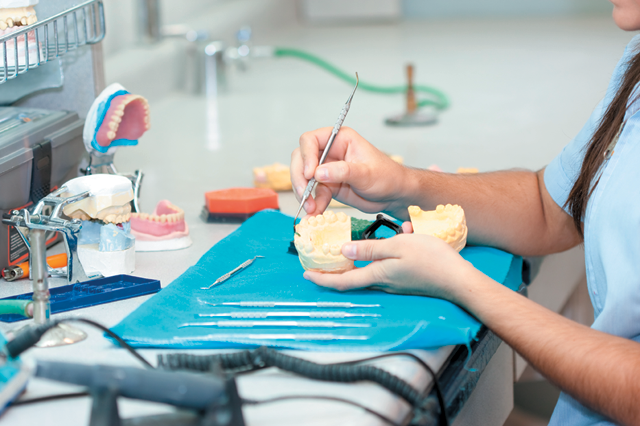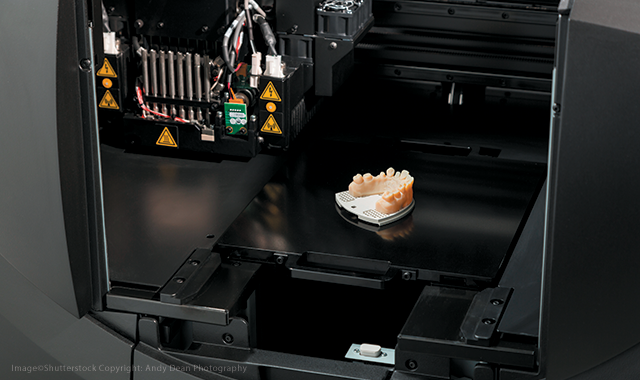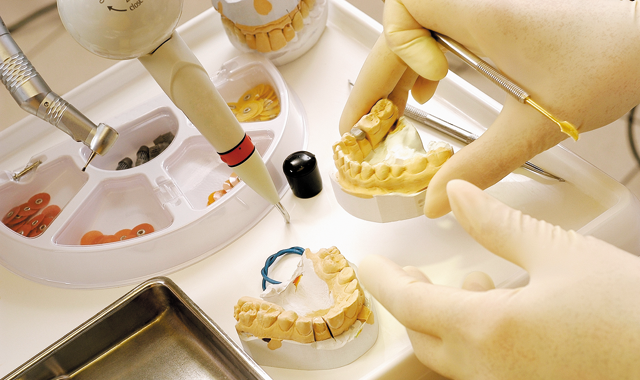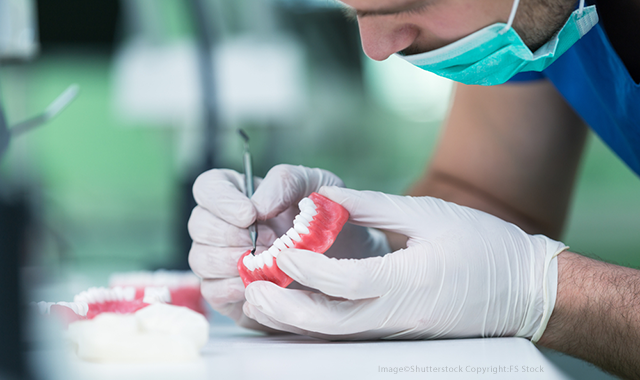3 reasons to be excited about dentures in 2019
From new software to updated materials, here's why dental professionals should look forward to advancements in dentures this year.
Dentures are rarely an exciting part of dentistry for clinicians. And patients typically aren’t that excited when you tell them they need dentures either.

However, that could change in the next 12 months, and that’s a good thing because dentures aren’t going away anytime soon.
“As patients continue to live longer, there are still going to be huge portions of the population that are going to need traditional dentures with no implants,” says Dr. John Huebner, a private practice general dentist from Lee’s Summit, Missouri. “Whatever we can do to make the process easier and get the best product outcome for the dentists or the patients is going to be a huge benefit.”
This year could be the year we start seeing these huge benefits, according to our experts. From new software to new materials to new techniques, there are many reasons to be excited about dentures in 2019.


3D printed partial and full dentures
Dr. Tae Hyung Kim is chair of removable prosthodontics in the division of restorative science at the Herman Ostrow School of Dentistry of the University of Southern California and has dedicated his research to making 3D partial and complete dentures. He invented a denture system, DENTCA, which uses computer-aided design and computer-aided manufacturing (CAD/CAM) with 3D printing technology to produce dentures.
Dr. Kim and his students at USC worked with many of their patients for multiple decades. He says many of his long-time patients who are familiar with how conventional dentures fit tell him how excited they are about 3D printed dentures.
“This is a huge benefit from the patient view,” Dr. Kim says.
One of the specific ways it helps patients is if they need a replacement. Dr. Kim says it’s common for his elderly or special needs patients to misplace their dentures. When that happened in the past, the dental team had to develop the dentures from scratch again. With digital dentures, however, clinicians don’t have to start at the beginning for a replacement set.
“Everything is digitally recorded, so it’s all there,” Dr. Kim explains. “You just push the button.”
3D printing for crowns and bridges is becoming commonplace and to varying amounts of success, depending on a number of factors. However, some of the challenges aren’t the same for dentures. Dr. Kim says 3D printing is better for removables than fixed restorations because dentures need less accuracy and strength than crowns and bridges.
“For denture teeth, the required physical properties are a lot lower than what we require for crowns,” Dr. Kim explains.
3D printed dentures are faster to produce than conventional dentures. The old school of thought taught that it took five appointments to fabricate a denture. Many practitioners have modified that process to four appointments and some even down to three, a move Dr. that Kim doesn’t recommend.
“Then you start sacrificing quality if you start pushing to three visits with conventional dentures,” Dr. Kim says.
With a digital denture, you deliver the same or better quality removables in three visits. In certain cases, Dr. Kim says you can push it to two visits, but that isn’t what he recommends.
“We teach three visits. At this moment, I don’t want to sacrifice any steps that we include so that it is properly done,” Dr. Kim says.
In the traditional technique, most practitioners have the patients come in for a try-in appointment with a wax denture to ensure it looks fine. However, they can’t test the denture at the try-in appointment because the teeth aren’t secured enough on the wax.
3D printed dentures make a testing denture instead of the teeth set in wax that you see with a conventional denture process. That means you can test the fit and the function too.
“We tell the patients, ‘Bring the food that you like - a sandwich, fruit, whatever you enjoy eating.’ We are actually testing before making the final removable,” Dr. Kim says.
In addition to the numerous benefits to the patient, there are benefits to the practice too. Reducing the number of visits to produce a denture benefits the practice’s bottom line. Also, they can be less expensive to produce, depending on who prints it.
“Some practitioners have a printer in their office that could save a lot of costs, not only time-wise, but manufacturing costs could be a lot different,” Dr. Kim says.
Regenerating the same denture for a replacement set with the push of a button relieves stress for the clinician. To make a second set, they just print it and deliver when the patient comes back. There’s no stress for the long-term maintenance and care for the patient.
“That’s completely different than what we had in the past. Nobody kept the master cast. Nobody kept the impression. That means if anything happens to the denture, you have to do the whole thing all over again,” Dr. Kim says.
Dr. Kim says 3D printed dentures dramatically progress how you manufacture removables and improve what you can deliver the patient, especially when compared to what has been available for the past few decades.
“The only reason I am excited about it is that we provide a better service to the patient,” Dr. Kim says. “If you are not changing the way you make dentures, you are not delivering the best dentures out there to your patient.”



New removable partial dentures materials
Dental materials are always improving, and denture materials are no exception. A new polymer could make removable partial dentures (RPD) much more comfortable for your patients to wear but without the drawbacks of previous polymer frame materials.
Dr. Huebner says he does more partials than full dentures with his patient population. Some patients aren’t good candidates for implants. However, he still needs to replace one or multiple teeth.
“A partial is really the only option,” Dr. Huebner says. “When you are trying to reach the goal of restoring function, but doing it in the most esthetic way possible, a partial really helps fill a void.”
For decades, removable partial dentures have been comprised of a pink plastic base, manufactured replacement teeth and a metal framework, usually made of a chrome-cobalt alloy or stainless steel. Sometimes clasps were used to connect them to the surrounding natural teeth. Other times precision attachments, sometimes secured by crowns on the natural teeth, were used.
However, there were drawbacks. RPDs could be difficult to insert and remove. Sometimes the clasps didn’t look great. Some patients felt like the appliances were bulky or awkward, or they needed adjusting to relieve sore spots. Also, cleaning could be time-consuming and detail-oriented.
Dr. Huebner says new polymer materials are hitting the market that could replace the metal portion of the RPD. He has been looking into the Ultaire™ AKP. AKP stands for aryl ketone polymer, and Ultaire AKP was designed to be an alternative for the metal RPDs, which patients have complained can be too stiff.
In addition to being metal-free, Ultaire doesn’t use metal clasps like traditional RPDs. It also addresses the strength issues that other flexible polymers had.
“Some of the flexible partial materials were slightly more esthetic than metals, but you didn’t quite get that same function that you do with the traditional metal framework. There is a gap there that is now starting to get filled with a nice alternative,” Dr. Huebner says.



Scanning and planning with the lab
Digital impressions make a significant impact on the process with partial and full dentures.
With a conventional denture fabrication, there’s a primary and secondary impression taken. Then those impressions are shipped to the lab.
Once the lab has the impression material, they make a physical model and flow the wax in the model. The denturist then creates a denture base and attaches the teeth with wax and ships it back to the doctor. Each step takes time and has a possibility of the proportions to shift around a little bit, rotate, or change the occlusion, among other problems.
Both our experts are fans of incorporating the digital workflow into full and partial dentures. Not only does it streamline the process from the two-impression conventional workflow, but it also prevents some of the distortion and adjustments necessary that occur with a traditional workflow.
“The nice thing about a digital impression, depending on how far away you are shipping your impressions or anything, you never have to worry about digital impressions distorting like some impression materials may do. You can rely on data,” Dr. Huebner says.
Another benefit of digital impressions for dentures and removable partial dentures is improved predictability. The lab gets the scan via email, where the technician can view it and request a new scan if anything is missing that the lab needs. Also, it gives both the technician and the doctor a chance to see the denture before fabricating it.
Libraries of teeth are available online to scroll through with every size, shade and shape of the tooth. Also, the scan allows the lab and dentist to make significant changes to the denture easily and to collaborate with the patients to improve the esthetics and minimize adjustments. Moreover, all of this occurs via email, which improves efficiency.
Dr. Huebner has only begun incorporating the digital workflow with partial dentures. He says, for now, he still makes traditional impressions with polyvinyl siloxane. The patient experience between the two types of impressions improves with digital scanning. He says patients like scanning over traditional impressions, especially those with a sensitive gag reflex.
“In the past, you said, ‘Let’s try and power through and get this done.’ Now, being able to do it digitally makes it so much easier for all parties involved. The patient goes through it easier, and you don’t have to worry about having a trash can close by,” Dr. Huebner says. “It makes the assistant’s and the dentist’s job a lot easier too.
Dr. Kim agrees that digital impressions make a significant difference in patient experience. Also, it produces a predictable outcome for the impression success.
“Once you learn how to make digital impressions, it’s a lot more consistent,” Dr. Kim says.
With 3D printed dentures improving the accuracy and speed of manufacturing, new materials providing options for RPDs making them more comfortable, and streamlining and progressing the outcomes of digital scanning, there are many reasons to be excited about dentures in 2019.
“Anything that can improve that process and make it easier for the dentist and the lab is going to help,” Dr. Huebner says. “And if it helps keep costs down, that’s a huge benefit too.”
